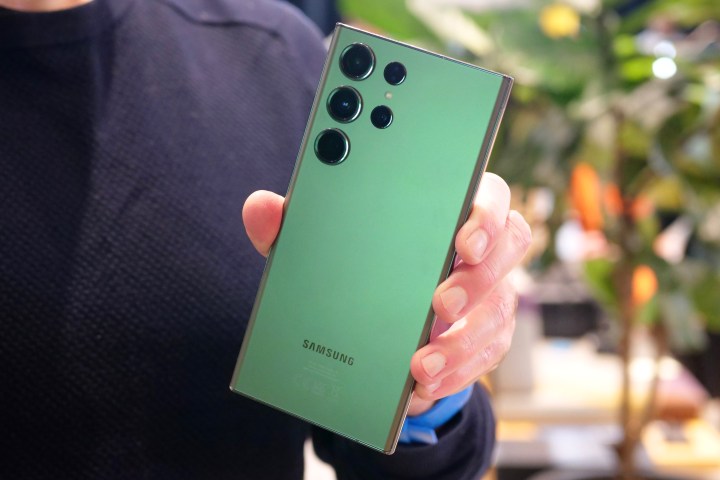At its Unpacked event last week, Samsung made some bold promises regarding the performance of its Galaxy S23 series phones. The company made quite some ballyhoo about the slightly faster trim of Qualcomm’s Snapdragon 8 Gen chip that is exclusive to these phones, touting a 41% gain in graphics performance.
Samsung proclaimed that “the most significant improvement is the optimized GPU which is approximately 41% faster,” adding that “the GPU architecture has been enhanced for performance and efficiency.” However, the more significant claim was about the reworked vapor chamber cooling system, which is fitted inside all three phones and “is now larger than before.”

Leaker Ice Universe also shared schematics of the bigger vapor chamber architecture fitted inside the Galaxy S23 trio, which replaces the thermal system at the heart of the Galaxy S22. Above is the official illustration — purportedly depicting the vanilla S23 or its Plus trim — on the Unpacked stage.
Why go big?
Now, a larger vapor chamber system is needed inside the Galaxy S23 series phones, because the CPU cores of its custom chip tick at a higher frequency. Plus, the GPU comes with a special ray tracing module for enhanced light and shadow rendering in games.
Here’s how Samsung imagines the difference created by ray tracing in mobile games:

Faster CPU cores, a beefier GPU, and an added ray-tracing module would mean more heat is generated inside that glass and metal chassis. The best way to handle that extra heat would be to offer more vertical space under the hood in order to keep things from getting toasty. That didn’t happen.
The heat dissipation area of Samsung Galaxy S23 series is increased, as shown in the figure. pic.twitter.com/XkTW91vIm2
— ICE UNIVERSE (@UniverseIce) February 2, 2023
If you compare the dimensions of the Galaxy S23 triad against their respective Galaxy S22 series counterparts, you’ll notice that the thickness remains the same. Needless to say, a better thermal management system was a necessity, and Samsung’s engineers appear to have met that need.
The company is hyping its latest flagships with claims of offering “the most powerful gaming experience yet.” And thanks to the larger vapor chamber cooling system, all that gaming potential will supposedly be realized without making the phone breathe fire out of its vents.

In fact, the launch event’s host promised “a PC-like gaming experience.” Now, I don’t personally agree with that analogy, but an efficient vapor chamber cooling system does make a tangible difference, especially during demanding tasks like playing high-end games or recording 4K videos.
Samsung has done a really good job with its vapor chamber cooling solutions in the past, even though the company has always been modest about the gaming chops of its camera-centric flagships. I extensively tested the Galaxy S22 Ultra against the OnePlus 10 Pro last year and found the Samsung phone performing noticeably better at everything from gaming to synthetic benchmarks.
I am expecting nothing less from the Galaxy S23 Ultra this year. However, I am more excited for the smaller Galaxy S23, which has a significantly tighter internal space for heat dissipation — yet supposedly doesn’t make any compromises in terms of raw performance compared to its Ultra sibling.

Of course, it’s challenging to keep the smaller model running as cool as its Ultra sibling under the same kind of load, but it would be interesting to see if Samsung’s engineers have truly managed to accomplish the unthinkable.
Samsung’s atoning for the sins of its past
When I tested the Galaxy S22 last year, heating was one of my biggest concerns. Be it gaming, video capture, or even charging, the compact phone warmed up rather quickly. Part of that problem can also be attributed to the Snapdragon 8 Gen 1, which had some well-known heating woes.
But there was another performance-related scandal that soon exploded into a full-fledged lawsuit in Samsung’s home market. Last year, it was discovered that Samsung was intentionally slowing down its Galaxy S22 flagships without proper disclosure.
At the heart of the issue was its Game Optimization Service — an in-house app that discreetly ran in the background to optimize the phone’s performance and battery life, while also keeping the rising internal temperature in check. Some synthetic tests found that the Galaxy S22 series phones were only delivering half the firepower that the processor was capable of when the GOS system was active in the background.
Samsung eventually accepted that its phone did engage in throttling for thousands of apps, all in the name of regulating the temperature and ensuring consistent performance. The company soon added a performance mode to its Game Booster app, which allowed users to tap into the processor’s full potential.

With the Galaxy S23, Samsung not only has to avoid a similar shady stunt, but it also needs to deliver on its promise of a PC-like gaming experience. The Snapdragon 8 Gen 2 inside the new latest Samsung flagships and its ray tracing chops will quite literally blow off some steam.
It would be interesting to see how the larger vapor chamber cooling system is going to keep things chill without compromising on the raw performance. The Digital Trends team has already started testing the Galaxy S23 series phones, and the findings will be out soon.
We will be putting Samsung’s claims to the test with extensive gaming tests and assess whether the enhanced vapor chamber cooling system actually yields any generation-over-generation gains. Stay tuned for the review coming soon. Meanwhile, check out this excellent explainer of how a vapor chamber cooling system works inside a phone, complete with tons of nerdy stats.





